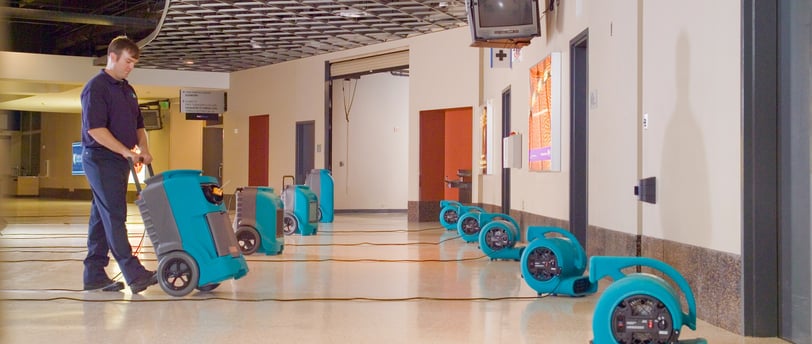Navigating the Waters: Comprehensive Solutions for Commercial Water Damage Restoration
Commercial Water Damage Solutions
11/29/20233 min read


Introduction:
Commercial water damage poses unique challenges that require swift and specialized solutions to minimize disruptions, protect assets, and ensure a rapid return to business operations. In this guide, we will explore the complexities of commercial water damage and discuss comprehensive solutions employed by restoration specialists to navigate these challenging waters.
Section 1: Understanding Commercial Water Damage
1.1 The Scale of Commercial Water Damage
Commercial properties, whether offices, retail spaces, or industrial facilities, often have larger footprints and intricate infrastructures. Water damage in these settings can be extensive, impacting not only the structural elements but also valuable equipment, inventory, and critical business operations.
1.2 Common Causes of Commercial Water Damage
Commercial properties are susceptible to various water damage sources, including leaks, burst pipes, roof damage, flooding, and appliance malfunctions. Identifying the source promptly is crucial for effective mitigation.
Section 2: Immediate Response and Mitigation
2.1 Rapid Mitigation Strategies
Time is of the essence in commercial water damage restoration. Rapid response teams are deployed to mitigate immediate risks, secure the premises, and initiate the first steps to prevent further damage.
2.2 Emergency Water Extraction
Industrial-grade pumps, wet/dry vacuums, and specialized extraction units are employed for swift water removal. Removing standing water is the foundation for successful commercial water damage restoration.
Section 3: Assessment and Planning
3.1 Professional Inspection
Certified water damage restoration specialists conduct a thorough assessment of the commercial property. Advanced tools, including moisture meters and thermal imaging, are utilized to identify hidden pockets of moisture and assess the extent of the damage.
3.2 Tailored Restoration Plans
Each commercial water damage incident is unique. Restoration specialists develop tailored plans that consider the specific needs of the business, the type of water damage, and the layout of the commercial space. A well-crafted plan ensures an efficient and targeted restoration process.
Section 4: Advanced Water Extraction Equipment
4.1 High-Volume Pumps
Commercial spaces often require high-volume pumps to handle large quantities of water. These industrial-grade pumps are capable of extracting water quickly, a critical factor in mitigating extensive damage.
4.2 Truck-Mounted Extraction Units
For large commercial properties or multistory buildings, truck-mounted extraction units provide mobility and power. These units combine powerful pumps and vacuum systems, making them effective in complex environments.
Section 5: Drying Techniques for Commercial Spaces
5.1 Desiccant Dehumidifiers
Desiccant dehumidifiers are highly efficient in large, open commercial spaces. They use moisture-absorbing materials to extract water vapor from the air, allowing for faster and more thorough drying.
5.2 Directed Airflow with Air Movers
Strategically placing air movers with adjustable airflow in commercial spaces promotes faster drying. This precision is crucial for large spaces with varying levels of water damage.
Section 6: Containment Strategies
6.1 Creating Containment Barriers
Containment strategies involve creating barriers to control the spread of water and contaminants. This is essential in commercial spaces to prevent the migration of damage to unaffected areas.
6.2 Negative Air Pressure Systems
Negative air pressure systems are employed to contain airborne contaminants during water extraction and drying. This is particularly crucial in situations where water damage involves contaminated or black water.
Section 7: Documenting the Restoration Process
7.1 Detailed Documentation
Comprehensive documentation of the restoration process is essential for insurance claims and business records. Restoration specialists meticulously document the assessment, mitigation, and restoration phases, providing a clear record of the restoration journey.
7.2 Communication with Stakeholders
Effective communication with business owners, property managers, and other stakeholders is crucial throughout the restoration process. Keeping all parties informed fosters transparency and trust, ensuring a collaborative and successful restoration effort.
Section 8: Coordination with Business Continuity Plans
8.1 Integrating Restoration with Business Continuity
Restoration specialists work collaboratively with businesses to integrate the restoration process with business continuity plans. This ensures that critical operations are prioritized, minimizing downtime and financial impact.
8.2 Temporary Relocation Strategies
In some cases, businesses may need to temporarily relocate during the restoration process. Restoration specialists coordinate with businesses to implement temporary relocation strategies that minimize disruptions.
Section 9: Advanced Monitoring Technologies
9.1 Remote Monitoring and Telemetry
Utilizing remote monitoring and telemetry systems allows restoration specialists to track moisture levels, temperature, and humidity remotely. This technology provides real-time data, enabling adjustments to the restoration process as needed.
9.2 Data-Driven Decision Making
Remote monitoring facilitates data-driven decision-making, ensuring that the water extraction and drying process is optimized for efficiency. This is particularly valuable in large-scale commercial restoration projects.
Section 10: Professional Expertise and Training
10.1 Certified Commercial Water Damage Restoration Specialists
Engaging certified commercial water damage restoration specialists ensures that solutions are applied with precision in the unique context of commercial properties. Specialists undergo specialized training to address the complexities of large-scale water damage incidents.
10.2 Collaborative Restoration Plans
Professionals collaborate with business owners and property managers to develop restoration plans tailored to the specific needs of each commercial property. This collaborative approach ensures a seamless and effective restoration process.
Conclusion:
Commercial water damage requires a strategic and specialized approach to mitigate risks, protect assets, and expedite the return to normal business operations. By leveraging advanced equipment, employing containment strategies, and coordinating with business continuity plans, restoration specialists navigate the waters of commercial water damage with precision. In the hands of certified professionals, comprehensive solutions ensure that commercial properties not only recover from water damage but emerge stronger and more resilient.
A-Z Dryout
3260 N Hayden Rd STE 210 Scottsdale. Arizona 85251
(480) 617-0978
azdryout@gmail.com
